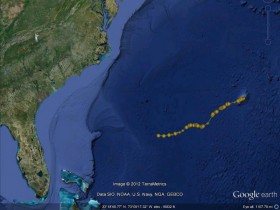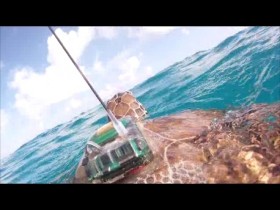Sea Turtle ‘Tucker’ Sucessfully Tracked
In August the Department of Conservation Services (DCS) fitted tags on three green turtles caught in three different seagrass meadows on the Bermuda Platform. The tags exchange signals with satellites orbiting the earth (satellite tags) letting DCS know where the turtles have been.
The satellite tag is attached to the back of the turtle so that when it comes to the surface to breath there is communication between the tag and a number of satellites. DCS is using the location data to better understand how the green turtles are using the Bermuda Platform.
For example how much time does a turtle spend in seagrass meadows, how much time does it spend in reefs, does it go to other habitats such as algal beds, does each turtle have a “home” location, how far do they go from home and how often?
When each turtle was caught it was fitted with a flipper tag, measured and weighed, and then a satellite tag was attached before it was released. Each tagged turtle was given a name:– Chubby, Catherine and Tucker.
During August and September the furthest any of the turtles travelled was approximately a mile from where they were captured for tagging. They all had certain areas within their mile radius that they would frequent.
However on 3 October Tucker became unusually adventurous and went for a long swim offshore before returning to his usual haunts near Wreck Hill on 5 October. On October 7, he again headed offshore, in a west south west direction, but this time he just kept going.
He has now travelled approximately 437 miles in a west southwest direction towards Florida. The satellite tag on Tucker should provide data on its location for the next 8 months.
“Although the tagged turtles were given names we do not know their gender because when green turtles are young you cannot tell if they are male or female by looking at them,” Sarah Manuel, Marine Conservation Officer.
“Blood tests are one way to determine their sex and a blood sample was taken from Tucker but we do not have the results of the blood tests yet,” Dr. Manuel added.
According to studies by the Bermuda Turtle Project (BTP) small green turtles come to Bermuda from other locations such as Florida, Mexico, Costa Rica and Cuba. As far as DCS knows none of the green turtles living around Bermuda hatched locally.
“These expat turtles take up residence around Bermuda feeding on seagrass and possibly other plants and animals such as algae and jellyfish. They are thought to stay here for up to 20 years but leave before they reach sexually maturity,” Dr. Manuel said.
“Like other turtles, we think they attempt to return, eventually, to the beaches where they originally hatched to reproduce themselves. The BTP estimates the average size of a green turtle when it leaves Bermuda is 70.6 cm (measured in a straight line from the front of the hard dorsal carapace to the posterior point).”
Green turtles caught around Bermuda and tagged with flipper tags by the BTP have been recaptured many years later in Nicaragua, Columbia, Cuba and Florida; only one green turtle tagged in Bermuda has been observed on a nesting beach, and that was in Mexico.
“Bermuda’s green turtles are clearly part of a multi-national turtle community and protecting them contributes to the welfare of turtles in many countries. But, the turtles of the other countries must also be protected so that there will be new generations of turtles to come to Bermuda.
“Like so many of the habitats and animals in the seas around us, turtles and their habitats can only be conserved through international cooperation and agreements.”
Regular updates on the locations of the Bermuda turtles fitted with satellite tags can be found on the Tour de Turtles Bermuda web site.
Read More About
Category: All, Environment




Go Tucker, go!!!
Go safely, little guy!
I hope that Tucker does not wander as far as Dominca where a turtle was hacked on the beach for food by fishermen.